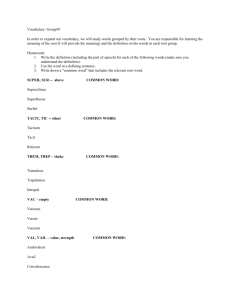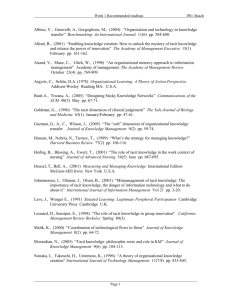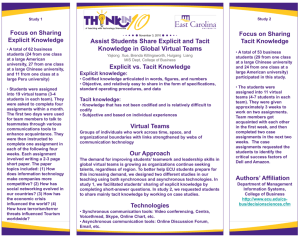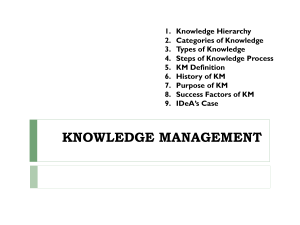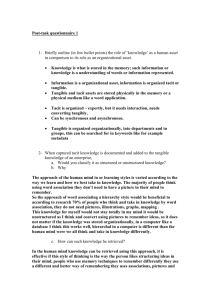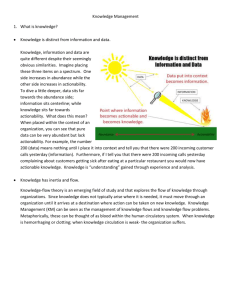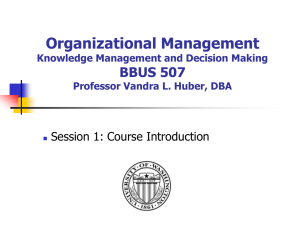A Model of Tacit Knowledge and Action Please share
advertisement
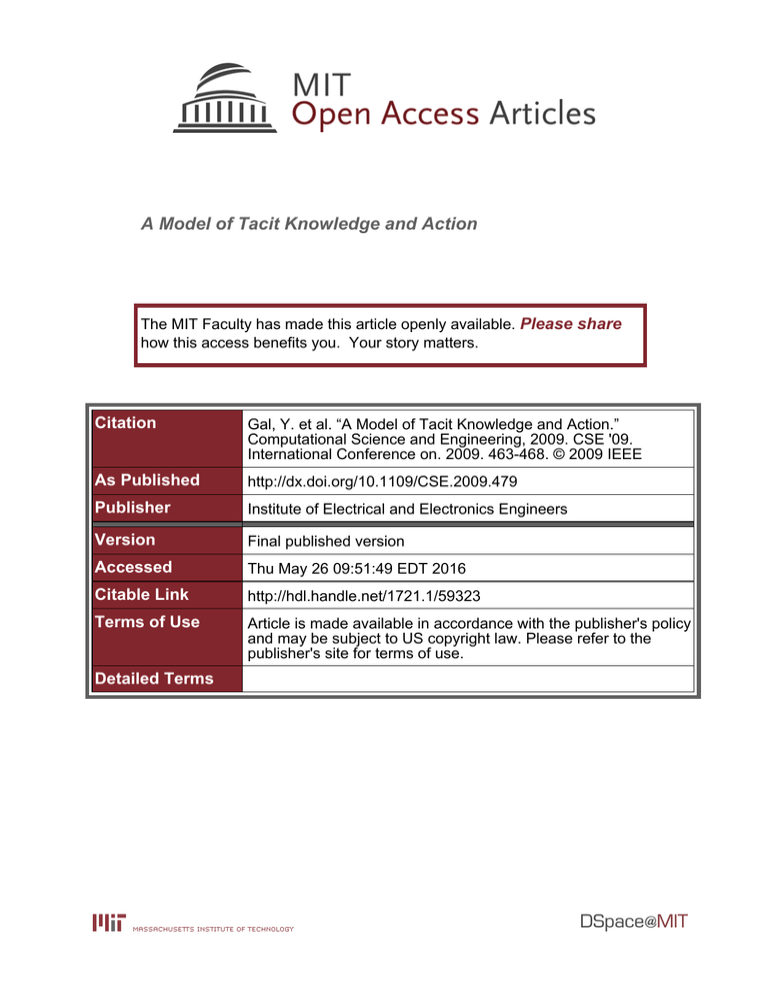
A Model of Tacit Knowledge and Action
The MIT Faculty has made this article openly available. Please share
how this access benefits you. Your story matters.
Citation
Gal, Y. et al. “A Model of Tacit Knowledge and Action.”
Computational Science and Engineering, 2009. CSE '09.
International Conference on. 2009. 463-468. © 2009 IEEE
As Published
http://dx.doi.org/10.1109/CSE.2009.479
Publisher
Institute of Electrical and Electronics Engineers
Version
Final published version
Accessed
Thu May 26 09:51:49 EDT 2016
Citable Link
http://hdl.handle.net/1721.1/59323
Terms of Use
Article is made available in accordance with the publisher's policy
and may be subject to US copyright law. Please refer to the
publisher's site for terms of use.
Detailed Terms
2009 International Conference on Computational Science and Engineering
A Model of Tacit Knowledge and Action
Ya’akov Gal
MIT CSAIL, and
Harvard University SEAS
Rajesh Kasturirangan
National Institute of
Advanced Studies
Bangalore, India, and
MIT CSAIL
I. A BSTRACT
Natural Intelligence is based not only on conscious procedural and declarative knowledge, but also on knowledge
that is inferred from observing the actions of others. This
knowledge is tacit, in that the process of its acquisition remains
unspecified. However, tacit knowledge is an accepted guide of
behavior, especially in unfamiliar contexts. In situations where
knowledge is lacking, animals act on these beliefs without
explicitly reasoning about the world or fully considering the
consequences of their actions. This paper provides a computational model of behavior in which tacit knowledge plays a
crucial role. We model how knowledge arises from observing
different types of agents, each of whom reacts differently
to the behaviors of others in an unfamiliar context. Agents’
interaction in this context is described using directed graphs.
We show how a set of observations guide agents’ knowledge
and behavior given different states of the world.
II. I NTRODUCTION
How do we infer the proper behavior in unfamiliar or
sensitive contexts? Suppose you are in a line, waiting to greet
a foreign dignitary. Do you bow, or do you shake hands? What
is the appropriate protocol? Similarly, at a formal dinner, what
would be the proper etiquette — especially in an unfamiliar
culture? Even the act of extended eye contact may be a faux
pas if you are facing a hostile gang or a malevolent dictator.
Studies show that humans (and presumably other animals
as well) act appropriately in the world without an explicit
representation of all of its features (Brooks, 1991; Gibson,
1977; Bonabeau, Dorigo, & Theraulaz, 1999).
We believe appropriate action must be based on tacit knowledge about how the world works. By tacit knowledge, we mean
implicit (though not necessarily unconscious) assumptions
about the world that guide action. The mark of tacit knowledge
is the lack of deliberation. Tacit knowledge is knowledge
whose veracity we do not evaluate using deliberate thought.
Our definition of tacit knowledge differs from other uses of this
term, for example, by Polanyi (1966), who requires that tacit
knowledge be unconscious (perceptual knowledge can be conscious without being evaluable) and by Crimmins (1992), who
requires that tacit knowledge involve implicit commitment to
beliefs about which one does not have a current opinion.
In this paper, we follow Janik (1990) in defining tacit knowledge as knowledge that in principle can be made conscious
and explicit, and evaluable when done so, but is currently
978-0-7695-3823-5/09 $26.00 © 2009 IEEE
DOI 10.1109/CSE.2009.479
Avi Pfeffer
Harvard University SEAS
Whitman Richards
MIT CSAIL
implicit. A simple example clarifies our use of this term.
When we choose to run a red light (common in Bangalore,
uncommon in Stockholm) we make decisions based on an
implicit knowledge of the context and actions appropriate to
that context. Such decisions rarely involve deliberation or selfreflexivity (which is the mark of explicit knowledge systems).
However, if forced to do so, we may be able to state explicitly
the trade-offs involved in running a red light (e.g., the fear
of being caught by a policeman vs. the need to get to the
destination as quickly as possible) and evaluate the tradeoffs. When running a red light, as in many other daily life
situations, we act tacitly though we could be fully conscious
and deliberative in principle.
Tacit knowledge — in combination with information from
other sensory modalities— is often invoked in new contexts.
For example, one general class of tacit knowledge revolves
around judgments of typicality and mimicry, i.e., “copy someone who looks like he knows what he is doing”. When waiting
in line to meet the foreign dignitary, one possible strategy is
to follow the actions of someone whose dress and mannerism
convey familiarity about the proper etiquette. Here typicality
is assessed by looking at dress and mannerisms, both of which
are provided by perception. Mimicry and typicality judgments
are tacit knowledge since they are not stated formally. We
are guided mostly by what other people do, not by rigorous
analysis and reasoning (Minsky, 1998).
Tacit knowledge allow agents to acquire knowledge and
infer accepted modes of behavior in new contexts without
fully reasoning about all the possible consequences of their
actions. People use tacit knowledge as a surrogate for what
is true in the world. Suppose that a driver that is unfamiliar
with the traffic laws in a particular country is waiting to turn
right behind a line of cars and can only see a school bus in
front. If the school bus turns right on a red light, the driver of
the car behind it may choose to follow its actions and do the
same. However, this driver may choose not to follow a beat-up
sedan. This is because this driver assumes the school bus to
be following the local rules, while the driver of the beat-up
sedan is believed to be reckless.
This paper presents work towards a computational theory of
the way tacit knowledge affects the way agents interact with
each other over time. Our approach is inspired by canonical
models of perception and language (Marr, 1982; Agre &
Rosenschein, 1996; Chomsky, 1965) that have laid down a
computational theory (by Marr for perception and Chomsky
463
for language), i.e., a formal statement of the constraints and
conditions regulating a visual or linguistic process.
We consider a setting in which multiple agents need to
make decisions, and interact with other agents as defined
by a graphical network. We incorporate several underlying
principles of tacit knowledge into our model. First, agents
use their own actions as a tool for conveying knowledge, and
use others’ actions as a guide for their own behavior. Second,
agents make decisions in a bounded way, that depends, under
certain conditions, on the actions of their neighbors. We show
how these assumptions facilitate the propagation of knowledge
and action in the network, and provide certain guarantees
about agents’ behavior for different network topologies. Lastly,
we use inference mechanisms in the model that are simple
in computational complexity, but are sufficient to describe a
variety of ways in which agents’ accrue knowledge and act
in the world. We do not mean to suggest that this model can
explain people’s performance but rather, that it describes, in a
principled, clear way the competence that underlies people’s
capacity for tacit knowledge.
III. A BASIC M ODEL
Initially we will consider a single action with values denoted
+ (e.g., turning right on red) and −. We use notation R+ and
R− to denote that the action is legal or illegal, respectively.
We also introduce a knowledge operator Kit (R+ ), specifying
that action + is known to be legal by agent i at time t or
Kit (R+ ), specifying that + is not known to be legal at time
t (and similarly for R− ). We drop these super- and sub-script
when they are clear from context.
Events are assumed to be consistent, such that R+ and R−
cannot both hold simultaneously. Knowledge in the model is
assumed to be correct, such that K(R+ ) −→ R+ . It follows
that knowledge is consistent, such that K(R+ ) −→ K(R− ).
(And similarly for R− ). We also assume that for each agent,
one of the following must hold: R+ is known to be true
(K(R+ )), R− is known to be true (K(R− )) or nothing is
known (K(R+ ), K(R− )). Consider the action of turning right
on a red light. This means that if an agent knows it is legal to
turn right on red, it cannot the case that the agent knows this
action to be illegal. Note that the converse does not hold. For
example, K(R− ) does not imply that R− holds. Intuitively,
not knowing whether it is illegal to turn right on red does not
imply that this action is illegal.
To capture the way different agents make decisions, we
introduce the notion of a type. In our model, a type essentially
refers to an agent’s strategy, and this strategy is specific to each
type of agent. Our use of types in this work is distinguished
from the traditional usage of this term as representing agents’
private information in game theory. Agents’ knowledge of
the types of agents they interact with is the way our model
captures tacit knowledge, as we will soon see.
We now introduce the following four types of agents,
representing four different strategies that can occur in this
example.
•
•
•
•
t1 (conservative). Choose action −. (Never turn right on
red)
t2 (law abiding). Choose action + if K(R+ ). (Turn right
on red only if you know it is legal)
t3 (risk taker). Choose action + if K(R− ). (Turn right
as long as you don’t know it is illegal)
t4 (reckless). Choose action +. (Always turn right on red)
A. Interaction Graphs
The relationship between multiple agents’ knowledge and
their actions is defined by a directed network called an
interaction graph. Each node in the network represents an
agent, an edge (i, j) determines that agent j knows the type of
agent i and that agent j can observe the action of agent i. The
first clause refers to one of the tenets of tacit knowledge, that
of knowing how others behave in various situations, though
the manner in which this knowledge is constructed in not
explicitly specified. The second clause is commonly used to
define interaction within networks. We will denote nodes in
the graph by their agent types when it is clear from context.
In the traffic example, the following network represents a
possible interaction graph describing a line of cars waiting to
turn right, in which an agent of type t3 is waiting behind an
agent of type t1 who is waiting behind an agent of type t2 ,
etc...
t4 → t2 → t1 → t3
To formally describe the interaction between tacit knowledge and action, we first detail how knowledge is conveyed
for each type of agent. We say that an agent conveys knowledge
if its actions provide information about rules in the world, or
about the knowledge of other agents about rules in the world.
• Types t1 and t4 never convey knowledge because the
strategies of these types do not depend on their knowledge.
• Type t3 conveys Ki (R− ) when it is observed to do −,
and conveys Ki (R− ) when it is observed to do +.
• Type t2 conveys Ki (R+ ) when it is observed to do +
and conveys Ki (R+ ) when it is observed to do −.
Consider for example an agent i of type t3 (reckless) and
an agent j of type t2 (law abiding). Suppose there is an edge
(t3 , t2 ) in the interaction graph, and that at at time step 1 we
have that Ki1 (R+ ), Kj1 (R+ ), Kj1 (R− ) (agent i knows that it
is legal to do +, and agent j does not know whether it is legal
or illegal). Following their type specifications, at time step 1,
agent i will do action +, and agent j will do action −. Now,
agent j cannot infer from the actions of agent i that R+ holds,
because a t3 agent that does + will not convey any knowledge.
Therefore at time step 2 we still have that Kj2 (R+ ), Kj2 (R− )
and following its type specification, agent j will choose to do
− again.
We now summarize the rules governing the behavior of
any agent in the graph given its directly observed neighbors.
Table I lists the actions for a row agent j and column agent
i given an edge (i, j) in the interaction graph. Each item in
the table is a tuple, in which the left entry states the action
464
TABLE I
ACTION TAKEN BY ROW AGENT j ON OBSERVING ACTION OF COLUMN
AGENT i
t1
t2
t3
t4
∅
∅
∅
∅
t1
(−)
(−)
(+)
(+)
−
+
+
+
t2
(−)
(−)
(+)
(+)
−
−
+
+
t3
(−)
(−)
(−)
(+)
t4
− (∅)
− (∅)
+ (∅)
+ (∅)
taken by j given that i chooses to do +, and the right entry
(between parentheticals) states the action taken by j given
that i chooses to do −. A ∅ symbol denotes a counter-factual
event — an action that cannot be chosen by a given type under
the circumstances. For example, it cannot be the case that an
agent of type t1 (conservative) is observed to do action +.
For example, according to the entry in row t2 , column t3 in
Table I, when t3 agent does action +, the t2 agent will do
action −, as we have shown above.
B. From Knowledge Conditions to Actions
We now show how this knowledge informs agents’ decisions
in the graph. We state the following theorem that specifies the
criteria by which knowledge and action interact in the graph.
Theorem 1. Let C be an interaction graph. A law-abiding
agent j of type t2 in C will choose to do + at time step t + l
if and only if the following hold:
t
• There is an agent i in C of type t2 such that Ki (R+ )
holds.
• There is a directed path in C from i to j of length <= l
that passes solely through agents of type t2 .
Similarly, an agent j of type t3 will choose action − at time
t + l if and only if Kjt (R− ) holds and there is a path from i
to j of length l that passes solely through agents of type t3 .
Using the theorem, we can induce a mapping from any agent
i and interaction graph C to a knowledge condition for j,
stating that j knows an action is legal (Kjt+l (R+ )), j knows
the rule is illegal (Kit+l (R− )), or that i does not know whether
the rule is legal or illegal (Kjt+l (R+ ), Kjt+l (R− )).
This theorem is easy to prove. Take for example a path
from R+ to an agent of type t2 . Any agent along this path
that is not of type t2 will not convey knowledge of R+ to
t2 , and therefore t2 will choose action −, as specified by
Table I. A corollary to this theorem is that at a given time
t, any knowledge that is conveyed by different paths in the
interaction graph is consistent. That is, any path of reasoning
in the graph will always yield the same action for an agent,
according to the theorem.
In our model, although agents can observe their neighbors’
types in the graph, they may not be able to infer what their
neighbors know. Consider for example two agents i and j,
both of type t3 (reckless). Suppose there is an edge (i, j) in
the interaction graph, and that at time t we have that Kit (R+ ),
Kjt (R+ ), Kjt (R− ) (agent i knows that it is legal to do +, and
agent j does not know whether it is legal to do +). At time
t, agent i will do +. Although agent j will also do action
+ at time t + 1, it will not have learned the rule R+ because
this knowledge cannot be conveyed by the actions of a t3 type
agent.
We now show that the relationships between types and
actions can be induced from the knowledge conditions that
hold for each agent. The possible knowledge conditions in
our examples are as follows:
1) {K(R+ ), K(R− )}
2) {K(R− ), K(R+ )}
3) {K(R+ ), K(R− )}
Note that the set {Ki (R+ ), Ki (R− )} cannot occur because
that knowledge is correct. We begin by defining an order over
knowledge conditions
(2) (3) (1)
Intuitively, this order represents a degree of severity: knowing
that it is illegal to turn right on is considered to be more severe
than knowing that it is legal. Similarly, not knowing whether
it is illegal to turn right on red is more severe than knowing
that this action is legal.
This allows us to reformulate agents’ types as a mapping
from knowledge states to actions. Thus, an agent of type t3
(risk taker) chooses action + if (1) and (3) hold, while an agent
of type t2 (law abiding) chooses action + solely if (1) holds.
Types t1 and t4 choose action + and action − respectively
for all possible sets of knowledge predicates. This is shown
in Table II. As can be seen in the table, it holds that once an
Type
t1
t2
t3
t4
(2)
−
−
−
+
Knowledge
Condition
(3)
−
−
+
+
(1)
−
+
+
+
TABLE II
R EFORMULATING T YPES USING K NOWLEDGE C ONDITIONS
agent type decides to choose action + for a given knowledge
condition, this agent will never choose an action − for a
knowledge condition that is more severe. For any of the types
shown above, it holds that if a knowledge condition K1 is
more severe than a knowledge condition K2 , then if an action
is known to be legal in K1 , it is also known to be legal in
the other knowledge condition. We call the types whose rules
of conduct meet these conditions monotonic. As an example
of a non-monotonic type, consider a “malicious” agent that
chooses action + solely under knowledge condition (2). This
agent chooses action + when it knows R− , and chooses action
− when it knows R+ .
We use the idea of monotonic types to characterize a set
of “sensible” types in our domain that facilitate the way
knowledge is propagated in the interaction graph. They also
serve to limit the space of possible types to consider when
performing inference. In general, if there are n binary rules,
there are three possible sets of knowledge predicates for each
465
rule, and the total number of possible sets is thus 3n . A type is
a mapping from each of these sets to an action + or −, so the
n
number of possible types is 2(3 ) , which is doubly exponential
in the number of rules. By only considering sensible types,
we can reduce this space considerably. By using Theorem 1,
one can determine the knowledge and the actions of particular
agents without having to enumerate all types.
IV. M ULTIPLE ACTIONS
In this section we extend the basic model above to handle
multiple actions. Let A is a set of actions. A value for an
action a ∈ A specifies whether it is legal (T ), illegal (F )
or unknown (U ). For each agent i, we define a knowledge
condition Kit to be a function from A to action values. A
knowledge condition in this model specifies a value for each
action in the domain. For example, if Kit (a) = F , this means
that i knows action a to be illegal at time t. (As before,
we drop the subscript when the identity of the agent is clear
from context). As before, a type is a mapping from knowledge
conditions to actions specifying what actions different agents
do given their knowledge about rules in the world.
In the basic traffic example there was a sole action, and
thus a knowledge condition described a complete mental state
for an agent about the domain. The number of possible mental
states is generally exponential in the number of actions, but we
can generalize the ideas we introduced in the basic example
such that values of particular actions will inform values of
other actions. To this end, we first impose a complete ordering
over action values that prefers legal actions to unknown
actions, and unknown actions to illegal actions. For any action
a ∈ A we have that
a=T a=U a=F
We can then define an ordering over actions, such that action
a1 dominates action a2 if for any agent i at time t, knowledge
that a2 is legal also implies that a1 is legal. (Note that the
direction of the ordering on both sides of the rule is reversed.)
a1 a2 =⇒ Kit (a1 ) Kit (a2 )
(1)
We are now ready to define an ordering over knowledge
conditions. Let Ki1 , Ki2 be two knowledge conditions for agent
i at two different points in time.
Ki1
Definition 2. We say that
is at least more severe than
knowledge condition Ki2 (denoted K11 Ki2 ) if the action
value that i knows in Ki1 dominates the value of the same
action in Ki2 .
Ki1 Ki2 ≡ ∀a ∈ A
Ki1 (a) Ki2 (a)
As in the basic traffic example, an order over knowledge
conditions implies a notion of severity, but Definition 2 extends
this notion to multiple actions. Intuitively, If Ki1 is more sever
than Ki2 , then if an action a is known to be legal in Ki2 , then
it must be the case that a is known to legal in Ki1 . In addition,
if a is unknown in Ki2 , then it cannot be the case that a is
known to be legal in K 1 .
We illustrate by an extension to the former example in
which the speed of the car is a discrete variable. Suppose that
the minimal driving speed is 10 MPH, and that speeds can
increase at intervals of 10 miles per hour. define an ordering
over any two speeds a1 , a2 such that a1 a2 if and only if
a1 > a2 . We will define an ordering over actions such that
driving at a slower speed always dominates driving at a faster
speed. Consider two speeds, 50 and 40 MPH. It follows from
Equation 1 that if Ki (50 = T ) holds for an agent i, then it
must be the case that Ki (40 = T ). (If 50 MPH is known
to be a legal speed, it follows that 40 MPH is also legal.)
If Ki (50 = U ) holds for an agent, then it must be the case
that Ki (40 = U ) or that Ki (40 = T ). (If it is unknown
whether 50 MPH is a legal driving speed, then it cannot be
the case that 40 MPH is an illegal driving speed). Lastly, if
Ki (50 = F ) holds, then any value for Ki (40) is possible. (If
50 MPH is known to an illegal speed, it may be legal or illegal
to drive at 40 MPH). In general, for any two actions a1 , a2
such that a1 a2 , the following knowledge conditions cannot
hold according to Definition 1.
(Ki (a1 = U ), Ki (a2 = F )),
(Ki (a1 = T ), Ki (a2 = U )),
(Ki (a1 = T ), Ki (a2 = F ))
Referring to our example, consider an agent i that at time
step 1 knows that the maximal driving speed is 40 MPH, and
at time step 2 learns that the maximal driving speed is 30
MPH. According to Definition 2, we have it that Ki1 is more
severe than Ki2 . To see this, consider any possible driving
speed a. If a <= 30, then it holds for i that Ki1 (a = T )
and that Ki2 (a = T ). If a > 40, then it holds for i that both
Ki1 (a = U ) and Ki2 (a = U ). If a = 40, then it holds for i
that Ki1 (a = T ) and Ki2 (a = F ). In all of these cases, we
have that K(a1 ) K(a2 ), according to Definition 2. Thus,
according to our model, the case in which a higher speed is
legal is strictly more severe than knowing that a lower speed
is legal.
We can use the mechanism above to provide a more general
definition of a monotonic type. Recall that a type is mapping
from knowledge conditions to actions.
Definition 3. A type T of agent i is monotonic if for any two
knowledge conditions Ki1 and Ki2 at two different points in
time, then the following must hold:
Ki1 Ki2 =⇒ T (Ki1 ) T (Ki2 )
The definition of a monotonic type resembles that of a
monotonic function. The prescribed action by a type for a more
severe knowledge condition must dominate the prescribed
action of a type for a less knowledge condition. In effect, this
means that a monotonic type will not decrease its speed as it
learns more severe information. For example, if an agent type
for i prescribes to drive at 30 when Ki1 (50 = T ) holds, then
it cannot prescribe to drive at 20 when Ki2 (60 = T ) because
466
LA
RT
LA
≤y
≥ y, ≤ z
RT
min
≤ y, ≤ z
TABLE III
L AW A BIDING AND R ISK TAKING AGENT T YPES
Ki1 ≺ Ki2 and 30 > 20. Note that it is quite possible for an
agent to break the law while still behaving monotonically. As
a simple example, consider an agent j that always drives at a
speed that is 10 MPH above the maximal speed that it knows
is legal.
Referring again to our example, we define the following
types of agents for any two speeds x1 , x2 and knowledge
condition K 1 : A law abiding agent will drive at speed x1
if K 1 (x1 = T ) (the agent knows that it is legal to drive
at speed x1 . A risk taker agent will drive at speed x1 if
K 1 (x1 > F ) (the agent will drive at a given speed if it
does not know that the legal speed limit is lower). The set of
monotonic types we introduced for the binary case generalize
to the multi-value case and it can be shown that these types are
monotonic, according to Definition 3. A law abiding agent will
not increase it speed unless it discovers that the speed limit is
higher. A risk taker will never increase its initial speed, it will
only lower it when it discovers that the speed limit is lower.
We can extend Theorem 1 to fit the case of multiple actions
that consider these two types. A law abiding agent type t
will drive at speed y (or below) if there is an agent i in the
interaction graph for which Ki (y = T ) holds, and a path
from this agent to t that is composed solely of law abiding
agents. (and similarly for a risk taking agent). Table III lists
the actions for a row agent j and column agent i given that
an edge (i, j) exists in the graph and that agent i is observed
to be driving at speed y. We use notation “RT” to refer to a
risk taking agent and “LA” to refer to a law abiding agent. A
law abiding agent always conveys that the speed limit is y.
Thus a risk taker that is observing a law abiding agent in the
network that is driving at speed y will do as follows: if the
risk taker is driving at speed below y, it will increase its speed
to y, because it learns Ki (y = T ), and thus the speed limit is
at least y. If the risk taker agent is driving at sped z > y, it
will not slow down, because it has not learned Ki (z = U ). A
law abiding agent that observes a risk taker driving at speed y
will not change its speed. However, a risk taker that observes
another risk taker will increase it speed if it is driving more
slowly.
V. D ISCUSSION
The interaction graph in our examples above was a simple
directed chain, with four different types of nodes arranged in
an arbitrary order. There are many other forms of interaction
graphs. Obvious cases are a leader of a group (connected
graph), or when everyone can see everyone else (complete
graph), a bipartite graph, random graphs, etc. With only 8
nodes, there are already 12,000 possible forms (Harary, 1969).
Note that Theorem 1, however, is general and lays out a
condition where knowledge of the graph form and node types
can lead to a correct action. Theorem 1 illustrates the larger
claim that whenever tacit knowledge is governed by underlying
principles such as the global consistency of knowledge, agents
have enough information to do the right thing. In addition,
our use of monotonic types allows to limit the inference to a
restricted set of sensible types that facilitate the propagation
of knowledge in the network.
The other interesting computational element in our model
is the use of monotonicity as a constraint to address a difficult
inverse problem, namely, to infer the “correct action” based on
observations of other agents behavior. In general, there cannot
be a unique solution to the problem of correct action, yet the
assumption that people fall into types constrains the inference
procedure. However, types alone are not enough. We need to
assume that both types of agents and the set of observations are
structured in a partial ordering. In our traffic example, types
are ordered according to their response to punishment (reckless
to conservative). We also assume that agents knowledge is
ordered as well, i.e., that no one ever knows less than she knew
before so observations always increase knowledge. These two
are distinct partial orders but they are related, for whenever
there is a scale of punishment, it helps if observations help
rather then hurt.
Finally, although the inference process may in some cases be
complex, our main intent is to present a simple representation
for evaluating how tacit knowledge can lead to correct actions
in unfamiliar contexts. The fact that tacit knowledge is largely
implicit, suggests how lower animals as well as humans can
learn appropriate behaviors without directed examples and
tutors.
VI. C ONCLUSION AND F UTURE W ORK
This work presented a computational model for how tacit
knowledge guides actions in settings where agents’ interaction
is described using a graphical network. The model incorporates
several principles of tacit knowledge that have been mentioned
in recent philosophical and psychological theories. First, that
agents use others’ actions as a guideline for their own behavior.
Second, that they forgo a rigorous analysis and make decisions
by only considering local information. We show how these two
principles facilitate the propagation of knowledge and action
in the network, and provide a set of guarantees about agents’
behavior.
We wish to extend the model in the following ways. First,
we wish to capture more general types, such as non-monotonic
agents (e.g., an agent that drives at least 45 MPH even if it
does not know the legal speed limit, never drives above 65
MPH, and drives at the maximal speed x that it knows to
be legal where 45 < x < 65.) To do so, we will introduce
modal logic operators and extend the knowledge conditions
to handle probabilistic events. Second, we are incorporating
cultural contexts into the model and showing how these effect
agents’ reasoning.
467
R EFERENCES
Agre, P., & Rosenschein, S. (1996). Computational theories
of interaction and agency. MIT Press.
Bonabeau, E., Dorigo, M., & Theraulaz, G. (1999). Swarm
intelligence: From natural to artificial systems. Oxford
University Press.
Brooks, R. A. (1991). Intelligence without representation.
Artificial Intelligence, 47, 139–159.
Chomsky, N. (1965). Aspects of the theory of syntax. MIT
Press, Cambridge.
Crimmins, M. (1992). Talk about beliefs. The MIT Press.
Gibson, J. J. (1977). The theory of affordance. In R. Shaw &
J. Bransford (Eds.), Perceiving, acting, and knowing.
Harary, F. (1969). Graph theory. Addison-Wesley.
Janik, A. (1990). Knowledge, skill and artificial intelligence
(B. Göranzon & I. Josefson, Eds.). London: SpringerVerlag.
Marr, D. (1982). Vision. Freeman and Co.
Minsky, M. (1998). The society of mind. Simon and Schuster.
Polanyi, M. (1966). The tacit dimension. London: Routledge
& Kegan Pual.
468
